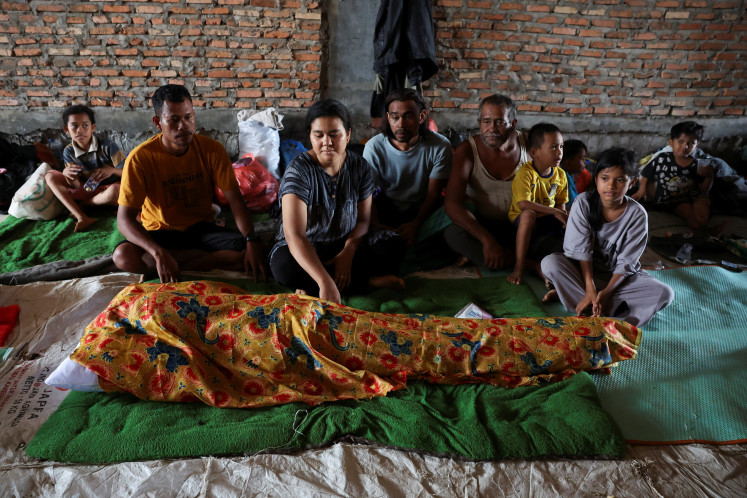Popular Reads
Top Results
Can't find what you're looking for?
View all search resultsPopular Reads
Top Results
Can't find what you're looking for?
View all search resultsKaliandra trekking: The march of the eco-tourists
Local villagers carry bundles of firewood along one of the trekking paths at the foothills of Gunung Arjuana
Change text size
Gift Premium Articles
to Anyone
Local villagers carry bundles of firewood along one of the trekking paths at the foothills of Gunung Arjuana. Locals have enthusiastically welcomed the trekking program, as it will add to their income through the opportunity to build and maintain tracks, and act as trek guides and accomodation hosts. (JP/Wahyoe Boediwardhana)
Call them flashpackers, or backpackers-plus to their face. These knowledge-hungry 60-somethings can be found in every corner of the world, out to flex their muscles as well as their minds.
Having conquered the Australasian wilderness they'll soon be heading for the mountains of East Java, if Janet Cochrane and her Indonesian colleagues have their way.
British academic Cochrane has done the hard yards in the tourism industry. Before teaching at Leeds University she led organized tours, including outdoor adventures.
She's also been a frequent visitor to Indonesia, so her surprise at the lack of development in hiking, eco and cultural tourism carries some clout.
"Trekking tours are extremely popular in other parts of the world," she said. "It's amazing that nothing has yet been successfully developed in Indonesia, other than hikes of a day or more up and down mountains that can be extremely challenging."
This dearth is now being tackled in central East Java, where a group of young Indonesians, backed by a conservation center and some of Cochrane's students, are developing a one-week trekking tour with the pedestrian title "A Walk Around Arjuna" (www.kaliandrasejati.org).
Arjuna, 3,339 meters high, stands between Surabaya and Malang Mountains. It last erupted in 1952. Its neighbor, Mount Welirang, is just 183 meters lower and is a well-known sulfur mine. For those brave or driven enough to enter the smoking crater, there's a 1,000-meter deep valley between the two peaks to traverse first.
"We want to create an experience where visitors can get involved in local culture and traditional arts," said Agus Wiyono, executive director of the Kaliandra Sejati Foundation, which runs an education and training center. "We'd like them to understand and maybe experience the cycles of rural life, including the harvesting of rice.
"To do this successfully we need to be supported by the local communities. We are taking things slowly and smoothly. We are calling this our 'pride campaign' and want it to encourage conservation of the environment. We don't want them to feel threatened."
Or exploited. The days when tourism was considered benign and a plus for the locals have long gone. The Bali experience, where farmers' land has been lost to hotels and the anticipated post-construction jobs went to outsiders, is a classic example of the downsides of tourism.
Cochrane said the negative impacts included arousing the desire for material goods, particularly the shiny, buzzy things that tourists carry. However mobile phone coverage in the Arjuna area is like the landscape -- full of holes. So the pleasure of arousing envy by browsing emails from Exeter while standing on the crumbling cusp of a smoking caldera will be limited.
Then there's the danger of infection from the glazy-eyed monotone "have a good day" virus that infects city supermarket checkout-chicks. It would be tragic if this sickness found its way into the Arjuna villages because the locals are genuinely friendly, even though their interrogation of visitors' age, faith and fertility can get a bit wearing.
Agus and his Kaliandra colleagues, Sapto Siswoyo and Agus Sugianto, have been organizing village meetings to help people understand what might happen when the trekking program gets underway in a big way. So far there have been nine sessions involving farmers and householders.
Agus Wiyono said the locals were enthusiastic because they had the chance to add to the income they currently earn from farming and forestry. They'll get the opportunity to build and maintain tracks, erect signs, act as tour guides and provide handicrafts, food and accommodation.
The other issue concerning the organizers is whether they should try to limit visitors.
If the trekking tours get too popular, cashed-up developers from outside might muscle in to build flashy resorts that would destroy the things that attract genuine eco-tourists.
Although the trekkers are likely to be hardy Europeans and Australians enjoying an active retirement on handsome pensions, they will still want their little comforts.
They may be prepared to forgo hot showers and sit-down toilets, but they will insist on cleanliness, and their desire for contact with nature will vanish if the little black things on the bedroom floor turn out to be rat droppings.
So the Kaliandra crew are busy explaining foreigners' needs and funny customs, like wanting to take part in some of the most boringly repetitious jobs in agriculture -- threshing rice by hand and pushing buffaloes to plow paddy.
As a tourist spot, Arjuna and its neighboring mountains have so many add-on attractions that even the most wilderness-worn will find something new. It's not just the views that make high-definition TV look like distorted transmissions.
The area is rich in culture and history, mystery and magic. For in these lush and fecund mountains the major religions haven't had the missionary successes they've enjoyed in the coastal cities.
Many ancient traditions and ceremonies have survived, particularly those involving planting and harvesting of crops. The locals will share these with outsiders, provided they're not trying to put a stop to these practices.
Then there's the chance to spot a rare Javan hawk-eagle, or the grizzled langur. Both are heading down the one-way track made by hundreds of other Indonesian birds and beasts, as forests are felled.
"There's a huge variety of things to see, from ancient temples and pristine montane forests to nightclubs, from hot springs and waterfalls, to tea plantations and rice fields," said Cochrane. The area is also cool -- Kaliandra is 850 meters up Arjuna. It's not quite outside mosquito range but they're not the saber-toothed brutes found on the steaming floodplains far below.
Although it will be another year before the long tour is ready for its first corrugated-sole footfall, shorter one-day tramps around Kaliandra are almost ready for business.










